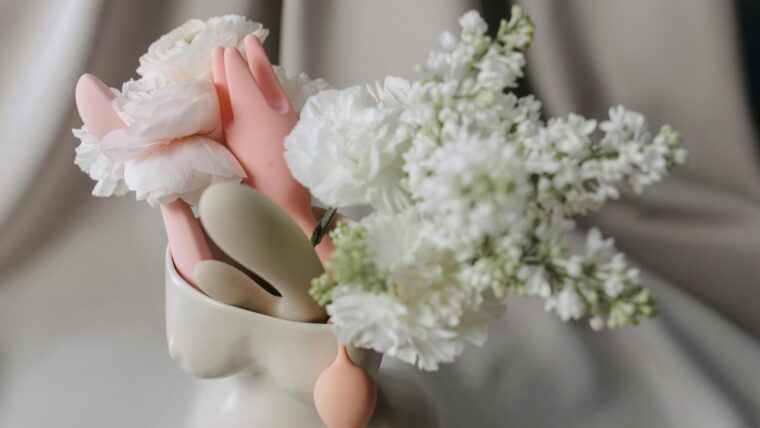Today I’m covering a little self help book on vaginismus I just finished: Living With Sex: The Secret to Solving a Big F*cking Problem.
This book gives a thorough synopsis of the mental approach to treatment, what it’s like viewing vaginismus from the doctor’s perspective, and her best advice on how to beat it through desensitization and creating new neural connections.
Dr. Julia Reeve is a gynecologist, psychotherapist, AND a sexologist, making her the expert on dyspareunia. She has treated patients suffering from vaginismus for over 25 years and thus developed her own 30 day guide for women trying to treat themselves at home.
She outlines the definition and various causes for this condition, dispels myths about the hymen, explains how to retrain your brain, teaches a few specific dilating methods, identifies feeling pain vs pressure, creates her own grades of Vaginismus, and shows us how to transition to PV sex (the first time she cleverly names as Day X).

What shocked me most about this book was simply that it’s the very first time I’ve seen anyone delve into the history of vaginismus.
Since studies on it weren’t much of a thing until the last couple of decades there isn’t a plethora of information out there, yet. However, Dr. Reeve took the time to research and discover the first suspected woman to have had vaginismus: Queen Elizabeth I!
This blew me away to read. There’s just something special about knowing even royalty can be plagued with the hardship this condition causes and “incapable of man”, as her medical records put it.
Another interesting fact is about the evolution of certain organs and reflexes. Apparently, the same muscles that cause mammals to tuck their tails between their legs when scared also enact the vaginismus reflex!

We have a tail as an embryo that disappears at 8-9 weeks, then forms the muscles in our pelvis. We are quite literally “tucking our tails” in fear to protect our bodies from perceived harm.
I also liked learning that our mouth is connected to our genitals because of the shape we start from in vitro, so pressing your lips together can also make your PC muscle tense and thus your vulva lips will feel tight, too.
This was also the first time I’ve seen anyone describe the actual formation of “the wall” covering the entrance to the vagina during a PC muscle spasm.
Dr. Reeve explains how the PC muscle isn’t just clamping shut, it’s narrowing and pulling forward, creating a bend above the hymen and into the vagina.
You can tell that the levator ani muscle has pulled the vagina and anus upwards so the canals no longer point straight down.
The visualization of this concept really helped me to comprehend what my body used to do and how to better explain it to future sexual partners.

Dr. Reeve asks that you provide yourself with an accountability partner, a list of goals, an award for each step accomplished, and that you visualize sex going well on the days you can’t dilate.
Besides the visualization, this was in line with the program I went through from vaginismus.com, so I agreed with the concepts laid out here.
I always recommend having someone that can dilate with you and commiserate with your progress, or lack thereof. This condition is a heavy weight to carry if no one knows what you’re dealing with and you’re far more likely to give up if you’re not confiding your dilating sessions’ outcomes with anyone.
I also believe awarding yourself for moving up in size, or even taking an additional step with your partner, gives you something to look forward to on this arduous journey.

Visualizing your success and planning out exactly what position you are going to try sex in is a must for me and it really does help take the pressure off in the moment so you can just dive right in.
In terms of the actual dilation portion, I found the visuals of the U shaped sling that the dilator must move through inside of the vagina very enlightening. This helped me understand why it feels so tight to get anything through sometimes and why each insertion is a bit easier than the last one.
I personally already do knocking and circling motions with my dilators because I’m using them for so long (9 years) that I like to get creative with them. I do agree that knocking helps with initial insertions, twisting helps when the dilator is sticking, and circling helps create more room.
Also discussed in the last book I read and reviewed, Come as You Are, Dr. Reeve goes into the idea of fight, flight, or freeze and how important it is to complete the cycle to relieve us of our stress.
The freeze response is common during a traumatic event, such as rape, and this can cause us to continue freezing when we encounter sex in the future.
It’s a hard pattern to break, but a necessary one to overcome Vaginismus. She suggests closing your eyes and pretending you are running away to escape the danger.
Some quote I’d like to call out are:
“It is when you try to make changes in your life, that the subconscious will try to sabotage leaving any comfort zones.”
“When you and your partner are ready for Day X, nothing should be left to chance.”
“Treating your Vaginismus is like painting a black wall white. You won’t succeed…in one go.”
My biggest issue with this book is the lack of proofreading. It’s professional, yet with grammatical errors on every 5 pages the presentation takes away from the merit of the information. I hope it will be re-edited before a round of reprinting takes place. I think this is such important subject matter and we need more books like this available on the shelves.
I’ve always been fascinated how in Europe you can actually go to a doctor’s office with your partner and have them teach you how to use dilators so I appreciated Dr. Reeve’s quotes from her patients’ and descriptions of their scenarios. That’s why women can overcome in just a month’s time over there.
Here in America we struggle trying to figure out what angle to insert them from, how much pressure to add, and even where the vaginal entrance is for months!We also have difficulty getting our male partners in the room with us to perform this daily act.
Making it the couple’s problem, rather than the individual’s problem, makes all the difference in overcoming this issue sooner and more effectively
I wish we had this option of getting coached in person here. Hopefully we are moving in the right direction with publicizing the success of this style of treatment and towards having this as a possibility in the states.
You can follow Dr. Reeve on Instagram at @dr.juliareeve and order her book from Amazon. If you are stuck in a feedback loop of fear, and not making progress trying to dilate, then this book is for you!
– Krista (33 years old, Houston, USA)
P.S. I invite you to check out my blog Chronicles Of A Broken Body.




